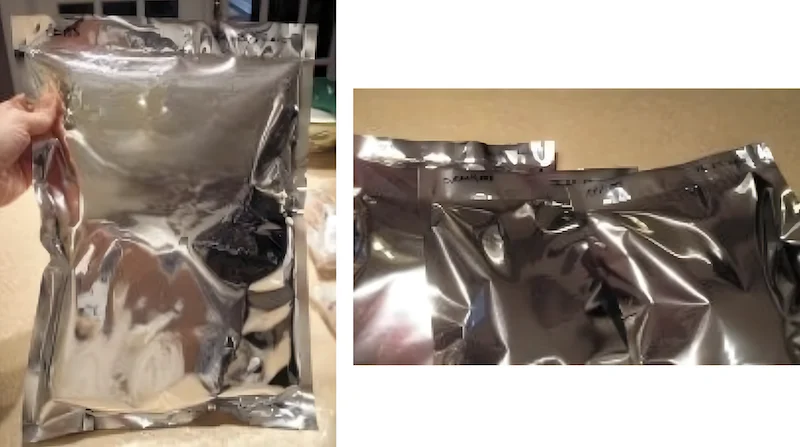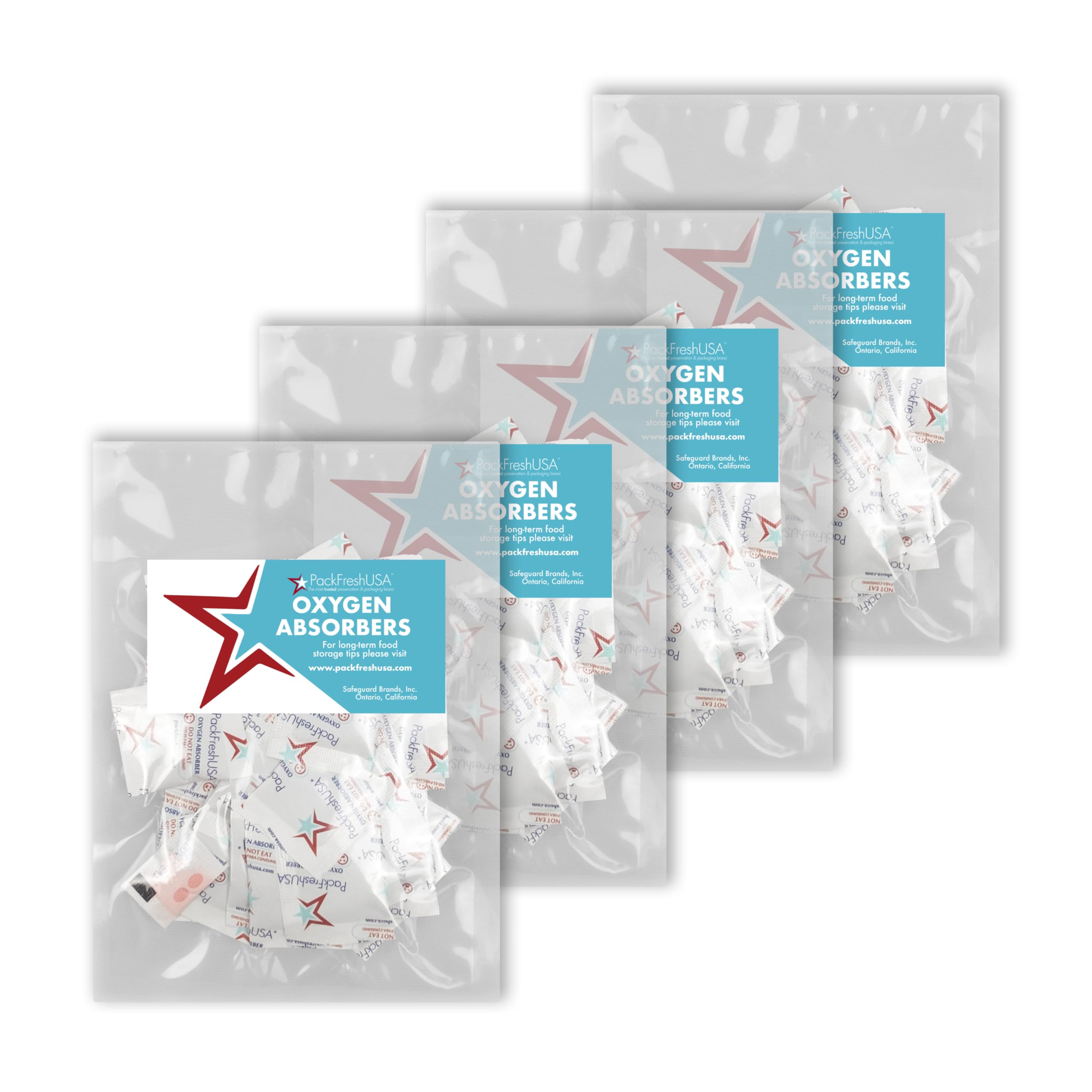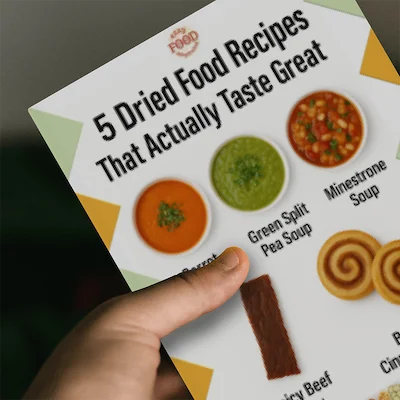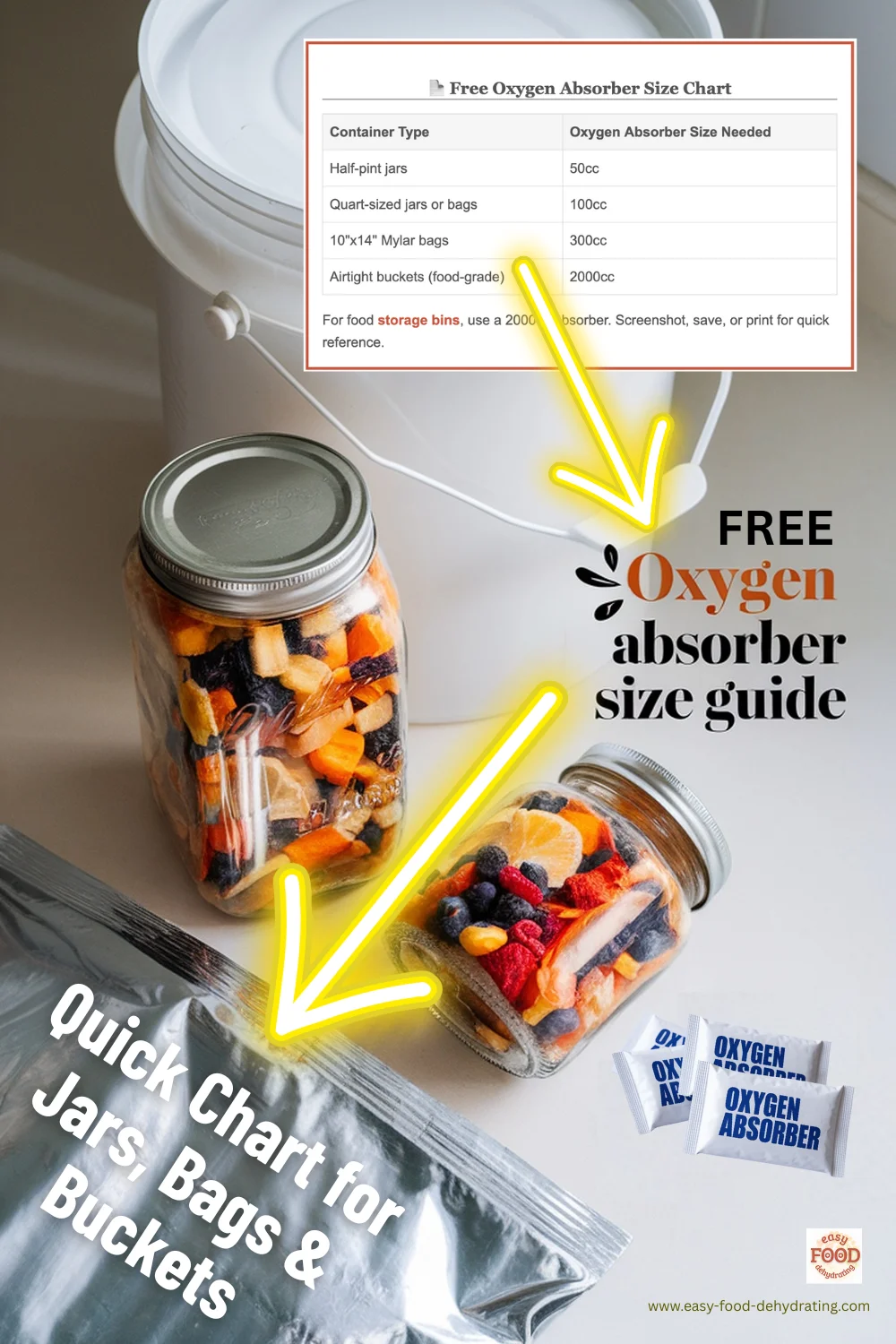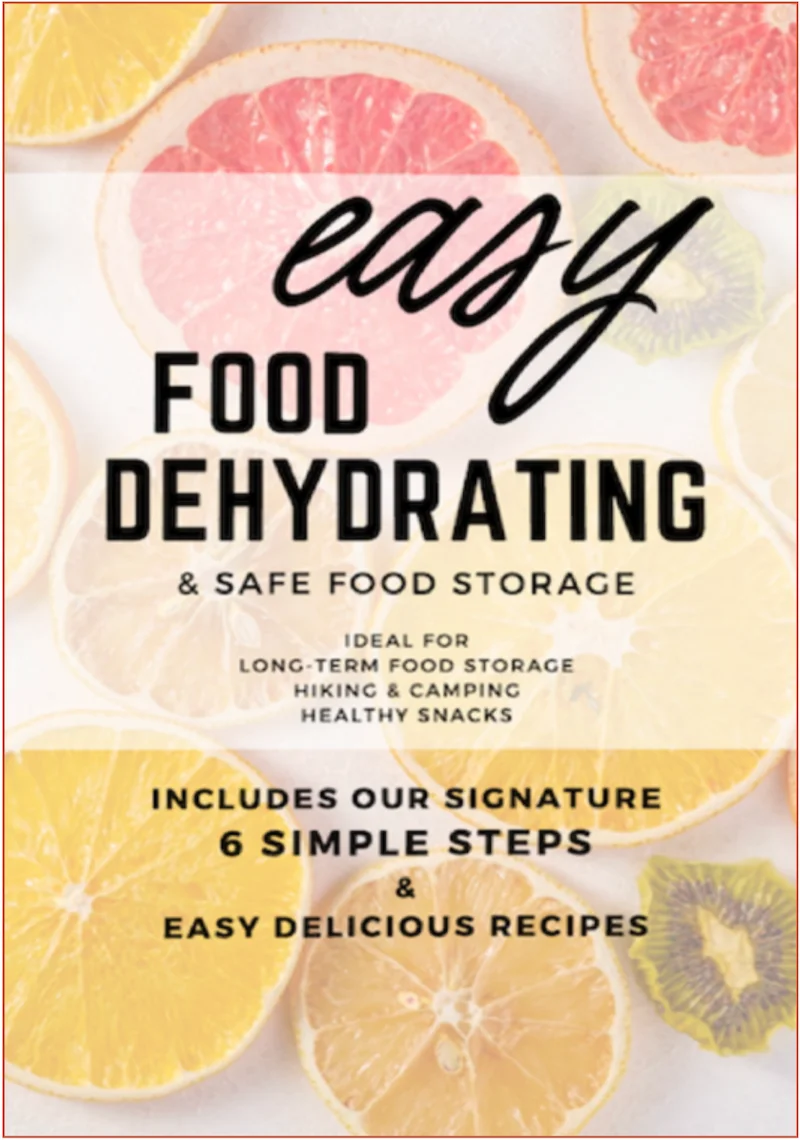What We Mean by “Dehydrate”
Here at Easy Food Dehydrating, “dehydrate” always means using an electric food dehydrator — the easy, reliable way to dry food at home.
- Home
- How to Store Dehydrated Food for Long-Term Freshness
- Oxygen Absorber Sizes
Oxygen Absorber Sizes: Chart & Usage Guide

In this guide, you’ll learn which size to use for jars, Mylar bags, and buckets - plus how to calculate the right amount for your food storage.
✅ Quick Answer: Which Oxygen Absorber Size Do You Really Need?
- 50cc → small jars
- 100cc → quart jars / vacuum-sealer bags
- 300cc → 1-gallon Mylar bags
- 2000cc → 5-gallon airtight buckets
Choosing the right size ensures your dehydrated food stays fresh and safely stored long-term. Rule of thumb: ~300cc per gallon
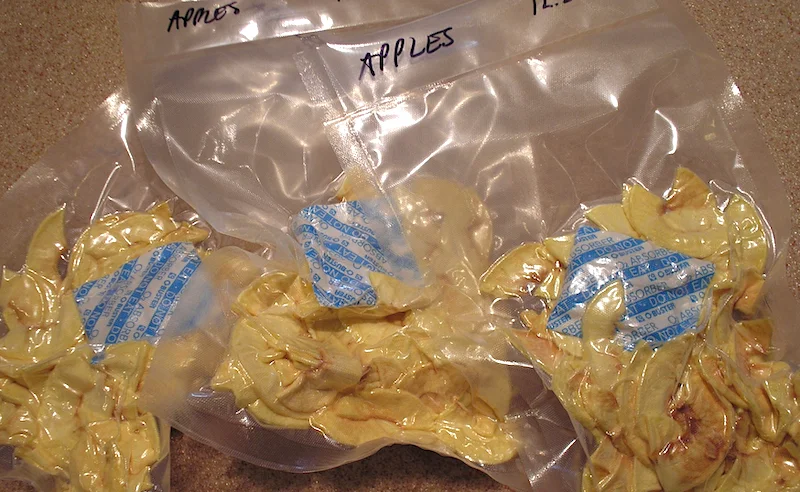 Three vacuum-sealed bags of dried apple slices, each containing a 100cc oxygen absorber for freshness and long-term storage.
Three vacuum-sealed bags of dried apple slices, each containing a 100cc oxygen absorber for freshness and long-term storage.How to Calculate the Right Size
I always match the absorber size to the container I’m using. If I’m sealing up a few herbs in a jar, a small 50cc packet does the job. When I move to a gallon of dehydrated vegetables in a Mylar bag, I know a 300cc packet gives me the right protection.
For bulk storage in 5-gallon buckets, 2000cc absorbers are non-negotiable. Using the correct size not only saves money but also ensures the packet actually does what it’s supposed to - capture stray oxygen before it damages your food.
For a deeper dive into how oxygen absorbers work, see my full guide about oxygen absorbers here.
Oxygen Absorber Sizes Explained
Oxygen absorbers come in different sizes, measured in cubic centimeters (cc). The size tells you how much oxygen the packet can remove from a sealed container. Small 50cc absorbers work well in spice jars or tiny containers, while 100cc packets handle pint and quart jars or vacuum-sealer bags.
For larger storage, 300cc packets are the standard choice for one-gallon Mylar bags, and 2000cc absorbers are made for five-gallon buckets. Each size has a specific role, and choosing the right one keeps your food safe and shelf-stable.
📄 Free Oxygen Absorber Size Chart
| Container Type | Oxygen Absorber Size Needed |
|---|---|
| Half-pint jars | 50cc |
| Quart-sized jars or bags | 100cc |
| 10"x14" Mylar bags | 300cc |
| Airtight buckets (food-grade) | 2000cc |
For food storage bins, use a 2000cc absorber. Screenshot, save, or print for quick reference.
Can You Use Too Many Oxygen Absorbers?
You don’t need to worry about using too many oxygen absorbers. Extra packets won’t harm your food - they’ll just stop working once they’ve captured all the oxygen in the container.
The real risk comes from using too few. If the absorber can’t remove all the oxygen, your food won’t store safely, and you could lose months of effort. When in doubt, go bigger or add an extra packet. It’s always better to overshoot than to fall short.
Shelf Life of Oxygen Absorbers
Unopened oxygen absorbers last about two years when you store them in a cool, dry place.
The sealed packaging keeps moisture and air out, so the packets stay fresh and ready to use. Always keep them in their original bag until you’re ready to open them.
Once opened, the clock starts ticking. If you reseal and vacuum the leftover absorbers right away in a Mason jar or a food vacuum-sealer bag (with a desiccant packet if desired), you can stretch their life another 6 to 12 months. The key is to limit their exposure to air — even a few minutes on the counter can start breaking them down.
Best Oxygen Absorber Brands Compared
Several brands make oxygen absorbers, but PackFreshUSA and Oxy-Sorb are the most widely available and reliable. O-Buster is established too, though it can be harder to source on Amazon and is sold directly at their website.
| Brand | Size Options | Packaging Type | Reliability | Best Use Case |
|---|---|---|---|---|
| PackFreshUSA | 50cc – 2000cc | Individually sealed packs, bulk bundles | ✅ Consistent, widely used | Everyday storage across jar, bag, and bucket sizes |
| Oxy-Sorb | 100cc – 2000cc | Mylar bags with resealable pouches | ✅ Long track record | Larger storage projects (Mylar bags + 5-gallon buckets) |
| O-Buster | 100cc – 2000cc (varies by seller) | Primarily bulk bags; fewer small multi-packs | ⚠️ Reliable but harder to source online | Alternative if preferred brands are unavailable |
When I shop on Amazon, I keep it simple: oxygen absorbers all do the same job, so I look for best-selling products that are repeatedly purchased and have consistent, recent reviews. That pattern usually signals fresh stock, reliable packaging.
Open, Seal, and Store for Freshness
👉 Pro Tip: Don’t leave oxygen absorbers sitting out on the counter. They’ll start activating within minutes. Always reseal the leftovers right away — vacuum-sealed jars or vacuum-sealer bags work best to keep them fresh.
In the photo below, the bag on the left shows a full, unopened 100-pack of 100cc oxygen absorbers. The red arrow points to the “freshness check pill.” On the right are my homemade vacuum-sealed packs of 20 absorbers each, ready for future use. At the very top is one of those 20-packs that I opened, removed a few absorbers from, and then resealed.
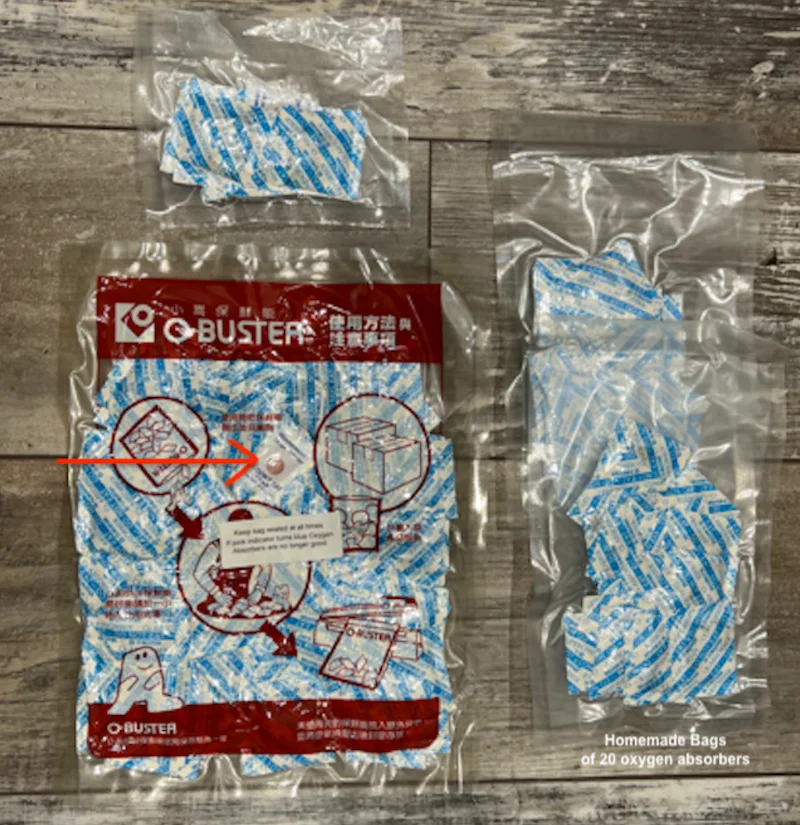 A full 100-pack of 100cc oxygen absorbers (left) with homemade vacuum-sealed packs of 20 absorbers each (right and top).
A full 100-pack of 100cc oxygen absorbers (left) with homemade vacuum-sealed packs of 20 absorbers each (right and top).By dividing a large pack into smaller portions, you extend the life of your oxygen absorbers. Just reseal each smaller pack immediately after opening so the rest stay fresh until you need them.
Using Oxygen Absorbers in Mason Jars
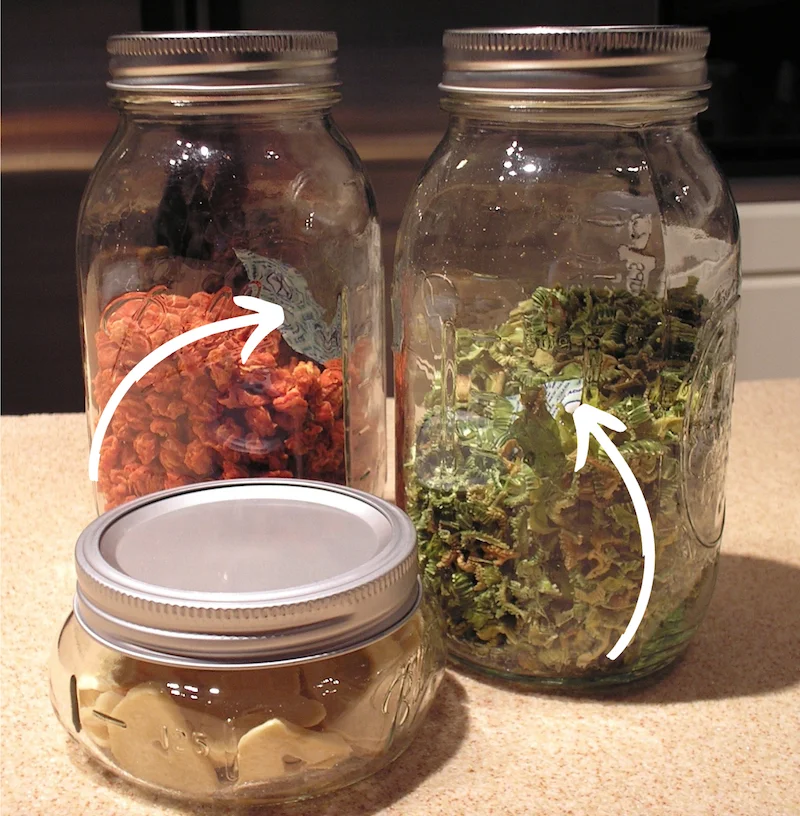 Quart mason jars show dehydrated carrots and celery with arrows pointing to the oxygen absorbers. Half-pint jar holds dehydrated elephant garlic slices.
Quart mason jars show dehydrated carrots and celery with arrows pointing to the oxygen absorbers. Half-pint jar holds dehydrated elephant garlic slices.The two quart-size Mason jars, pictured above, each contain a 100cc oxygen absorber to preserve dehydrated carrots, celery, and garlic. If you look closely you can see the blue and white oxygen absorber packet on top of the dried carrots and among the dried celery (the tall jars).
The small half pint jar uses a 50cc oxygen absorber.
Now that you’ve seen how to prepare absorbers for use, let’s explore their role in long-term storage.
NOTE: Feel free to also add a desiccant packet inside jars and bags when storing long-term. Read all about them below:
A NOTE HERE about DESICCANT PACKETS
Use them in conjunction with Oxygen Absorbers.
Here's How and Why...
How to Use Oxygen Absorbers in Mylar Bags
Mylar bags are perfect for storing vacuum-sealed pouches long-term. Here’s how:
- Place your vacuum-sealed pouches (with a 100cc absorber) inside the Mylar bag.
- Add a 300cc oxygen absorber to the Mylar bag.
- Seal the Mylar bag.
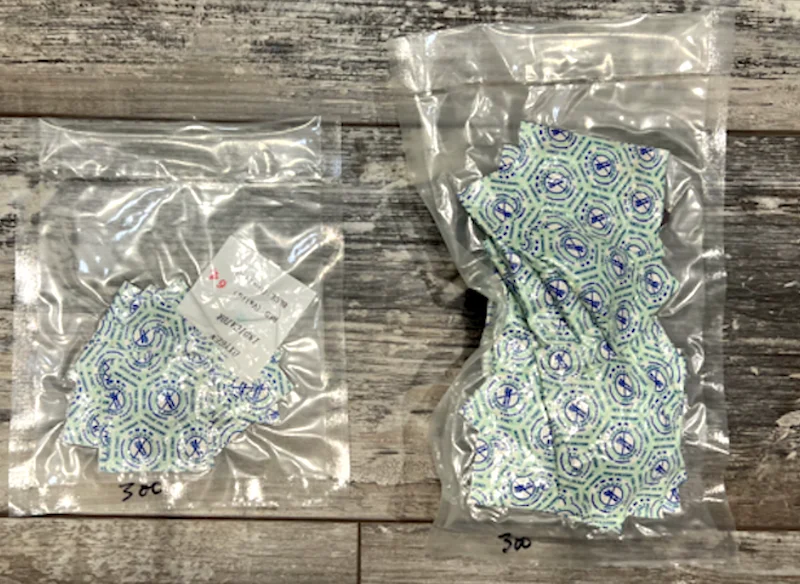 300cc oxygen absorbers divided into smaller amounts and sealed in food vacuum sealer bags for easier use and longer freshness.
300cc oxygen absorbers divided into smaller amounts and sealed in food vacuum sealer bags for easier use and longer freshness.Using 2000cc Absorbers in Airtight Buckets
For serious long-term storage, use 2000cc oxygen absorbers in food-grade, airtight buckets.
- Avoid buckets with poorly sealed lids or built-in handles, as they’re not airtight.
- Store Mylar bags inside buckets for added protection.
Oxygen Absorbers Available on Amazon
When to Use 50cc Oxygen Absorbers
50cc are perfect for small jars and containers. Ideal for keeping spices and smaller dried foods fresh.
Best Uses for 100cc Oxygen Absorbers
100cc are great for quart-sized jars and vacuum-sealer bags. The most versatile size for everyday use.
- PackFreshUSA Oxygen Absorbers
- 200-Pack
- Food-Grade, Non-Toxic
- Oxy-Sorb Oxygen Absorbers
- 100-Pack
- Long-Term Food Storage Freshness Protection
- Oxy-Sorb Oxygen Absorbers
- Bags of 20 (60 Count total)
- Super Effective for Dried Goods
- Oxy-Sorb Oxygen Absorbers
- Pack of 10
- I use these for airtight bins and buckets
As an Amazon Associate, I earn from qualifying purchases — this does not affect the price you pay. Read full disclosure.
What’s Actually Inside an Oxygen Absorber Packet
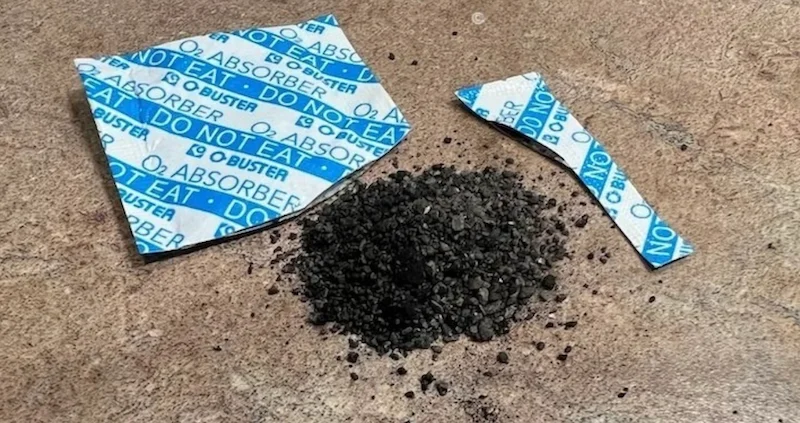 A cut-open oxygen absorber packet reveals the dark iron powder mixture inside. The iron oxidizes to remove oxygen from stored food containers.
A cut-open oxygen absorber packet reveals the dark iron powder mixture inside. The iron oxidizes to remove oxygen from stored food containers.When you slice open an oxygen absorber, you’re looking at the guts: mostly iron powder, with a pinch of salt and sometimes activated carbon. As the iron meets the moisture inside your sealed container, it oxidizes (turns to rust) and in the process eats up the oxygen around it.
That pile is just the ‘spent’ absorber doing its job — cleaning the air so your food lasts longer.
Take your food storage to the next level! Bookmark this page or share it with a friend who’s learning to preserve food safely!
Your Top Questions About Oxygen Absorber Sizes, Answered
What size oxygen absorber for a quart jar?
What size oxygen absorber for a quart jar?
100cc per quart jar. If the jar isn’t packed full or you’re unsure about headspace, add a second 100cc.
How many 300cc packets for a 1-gallon Mylar bag?
How many 300cc packets for a 1-gallon Mylar bag?
One 300cc is standard. If the bag has a lot of headspace, use 2 × 300cc.
Can I use too many?
Can I use too many?
Not really. Extra absorbers simply stop working once they’ve captured the oxygen. Using too few is the risk.
How long do unopened absorbers last?
How long do unopened absorbers last?
About 2 years in a cool, dry place. Check the freshness indicator (pink = good; blue/purple = spent).
What about opened packs?
What about opened packs?
Once opened, reseal the leftovers immediately in a vacuum-sealed jar or vacuum sealer bag. That’s the only way to keep oxygen out. Don’t rely on zipper bags — they let in too much air. Properly sealed, your absorbers will last another 6–12 months.
Do I need desiccants too?
Do I need desiccants too?
For very dry foods, desiccants help control moisture. Use them in addition to oxygen absorbers, not instead of them. See my guide: Desiccant Packets.
Which brands do you recommend?
Which brands do you recommend?
I use PackFreshUSA and Oxy-Sorb brands. See the comparison table above for sizes and packaging types.
Now that you know exactly which oxygen absorber sizes to use for jars, Mylar bags, and buckets, you’re set up for safe, long-term food storage. The next step? Putting that storage to good use with meals you’ll actually enjoy.
That’s why I put together my free 5 Dried Food Recipes You'll Actually Love PDF (below) — including my favorites like hearty carrot soup, classic minestrone, split pea comfort soup, spicy beef jerky, and even sweet banana cinnamon rolls. Grab your copy and start turning your stored food into meals that taste as good as the day you dried them.
Get 5 Dried Food Recipes You'll Actually Love
Here's where you can get your copy of our all new
5 Dried Food Recipes (That Actually Taste Great)
They're my all-time favorite easy dried food meals!
Get it here right now.
For Free!
Before You Go...
If you enjoyed this page, tap the ❤️ in the lower right-hand corner.
It saves this page to your Grow bookmarks so you can find it again later.
You’ll also see quick share buttons to copy the link, post to Facebook,
or save it straight to Pinterest.
